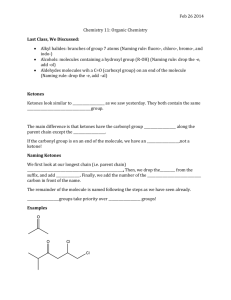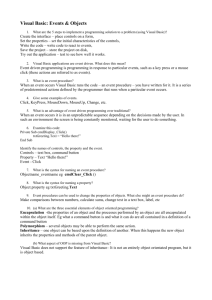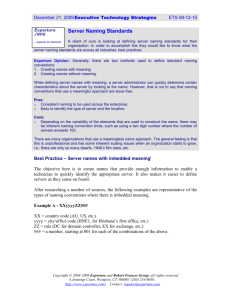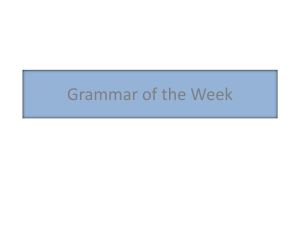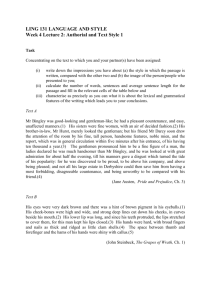History of Math: Ancient arithmetic
advertisement
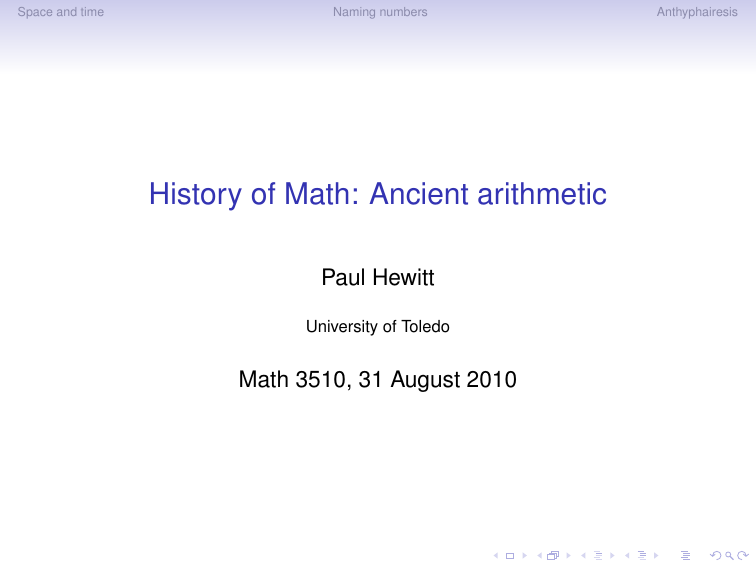
Space and time Naming numbers History of Math: Ancient arithmetic Paul Hewitt University of Toledo Math 3510, 31 August 2010 Anthyphairesis Space and time Naming numbers Outline Space and time Anthyphairesis Space and time Naming numbers Outline Space and time Naming numbers Anthyphairesis Space and time Naming numbers Outline Space and time Naming numbers Anthyphairesis Anthyphairesis Space and time Naming numbers Outline Space and time Naming numbers Anthyphairesis Anthyphairesis Space and time Naming numbers Rome: the beginning The Roman Republic arose when Greek and Phoenician colonies dominated the Mediterranean and Black Seas Anthyphairesis Space and time Naming numbers Rome: republican timeline • Senate overthrows monarchy: −509 • Control of Italy: −265 • Punic wars: • −264 to −241 • −218 to −201 • −149 to −146 • Control of Greece: −146 • Control of Turkey and the Levant: −62 • Conquest of France: −52 • Julius Caesar murdered: −44 Anthyphairesis Space and time Naming numbers Rome: imperial timeline • Caesar Augustus: −27 • Conquest of Britain: +47 • Destruction of Temple: +70 • Roman conquests at maximum: +117 • Age of Empires: −200 to +200 • Imperial crisis: +235 to +284 • Diocletian divides empire: +285 • Constantine adopts Christianity: +312 • Odoacer conquers Rome: +476 • Mehmet conquers Constantinople: +1453 Anthyphairesis Space and time Naming numbers Outline Space and time Naming numbers Anthyphairesis Anthyphairesis Space and time Naming numbers Place value systems • Hindu-Arabic • Chinese counting board • Iraqi sexagesimals • Mayan vigesimals • Egyptian binary arithmetic Anthyphairesis Space and time Naming numbers The decimal system If we divide 41891 by ten then we obtain A. a remainder of 1. B. a quotient of 4189. C. 4189 groups of ten, with one left over. D. All of the above. E. None of the above. Anthyphairesis Space and time Naming numbers Triskaidekaphobia If we express 41891 in base thirteen then the last digit is A. the remainder of 41891 ÷ 13. B. the quotient of 41891 ÷ 13. C. the number of groups of thirteen contained in 41891. D. All of the above. E. None of the above. Anthyphairesis Space and time Naming numbers Change of base 41891ten =?thirteen Anthyphairesis Space and time Naming numbers Change of base 41891ten =?thirteen 41891 = 13 × 3222 + 5 3222 = 13 × 247 + 11 247 = 13 × 19 19 = 13 × 1 + 6 1 < 13 Anthyphairesis Space and time Naming numbers Change of base 41891ten =?thirteen 41891 = 13 × 3222 + 5 3222 = 13 × 247 + 11 247 = 13 × 19 19 = 13 × 1 + 6 1 < 13 Anthyphairesis Space and time Naming numbers And the answer is. . . Hence 41891ten A. 5, 11, 0, 6, 1thirteen B. 1, 6, 0, 11, 5thirteen Anthyphairesis Space and time Naming numbers Unit fractions What is the ratio 41891 : 13? Anthyphairesis Space and time Naming numbers Unit fractions What is the ratio 41891 : 13? 3222 and a little bit. How much extra? Anthyphairesis Space and time Naming numbers Unit fractions What is the ratio 41891 : 13? 3222 and a little bit. How much extra? 41891 : 13 is 3222 and 5 : 13. Anthyphairesis Space and time Naming numbers Unit fractions What is the ratio 41891 : 13? 3222 and a little bit. How much extra? 41891 : 13 is 3222 and 5 : 13. OK, so what is 5 : 13? Anthyphairesis Space and time Naming numbers Unit fractions What is the ratio 41891 : 13? 3222 and a little bit. How much extra? 41891 : 13 is 3222 and 5 : 13. OK, so what is 5 : 13? 5 is a bit less than half of 13, but more than the third part: 5 1 2 1 1 1 = + = + + . 13 3 39 3 20 780 Anthyphairesis Space and time Naming numbers Anthyphairesis Unit fractions What is the ratio 41891 : 13? 3222 and a little bit. How much extra? 41891 : 13 is 3222 and 5 : 13. OK, so what is 5 : 13? 5 is a bit less than half of 13, but more than the third part: 5 1 2 1 1 1 = + = + + . 13 3 39 3 20 780 Hence 5 is a third part of 13 plus a twentieth part plus another seven-hundred-eightieth part. Space and time Naming numbers Outline Space and time Naming numbers Anthyphairesis Anthyphairesis Space and time Naming numbers What is π? Anthyphairesis Space and time Naming numbers What is π? • Ratio of circumference to diameter Anthyphairesis Space and time Naming numbers What is π? • Ratio of circumference to diameter • A bit more than 3 Anthyphairesis Space and time Naming numbers What is π? • Ratio of circumference to diameter • A bit more than 3 • Closer to 3 and 1/7 Anthyphairesis Space and time Naming numbers What is π? • Ratio of circumference to diameter • A bit more than 3 • Closer to 3 and 1/7 • But not really 7. . . closer to 7 and 1/15 Anthyphairesis Space and time Naming numbers What is π? • Ratio of circumference to diameter • A bit more than 3 • Closer to 3 and 1/7 • But not really 7. . . closer to 7 and 1/15 • Or perhaps 7 and 1/16 ? Anthyphairesis Space and time Naming numbers How’d we do? Anthyphairesis Space and time Naming numbers How’d we do? 1 22 C ≈3+ = D 7 7 1 333 ≈3+ = 7 + 1/15 106 1 355 ≈3+ = 7 + 1/16 113 error: − 0.001264489 . . . error: + 0.000083219 . . . error: − 0.000000266 . . . Anthyphairesis Space and time Naming numbers Roots • anthyphairesis = anti-hypo-hairesis = “reciprocal subtraction” Anthyphairesis Space and time Naming numbers Roots • anthyphairesis = anti-hypo-hairesis = “reciprocal subtraction” • “hairesis” can mean “taking” or “choosing”. So “hypo-hairesis” is a direct cognate of “sub-traction”. Anthyphairesis Space and time Naming numbers Roots • anthyphairesis = anti-hypo-hairesis = “reciprocal subtraction” • “hairesis” can mean “taking” or “choosing”. So “hypo-hairesis” is a direct cognate of “sub-traction”. • Curiously, “hairesis” has the same root as “heresy”. Anthyphairesis


